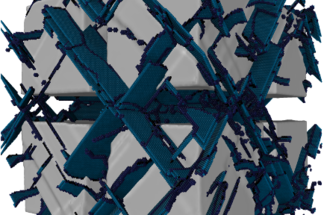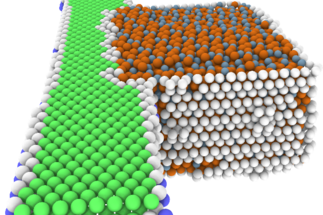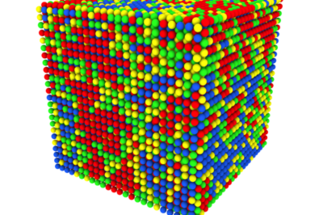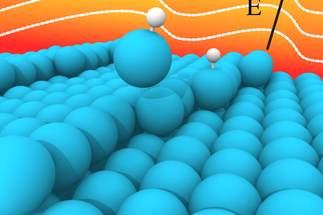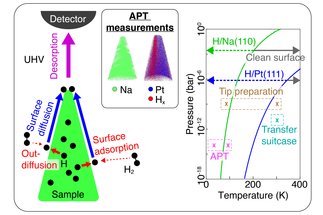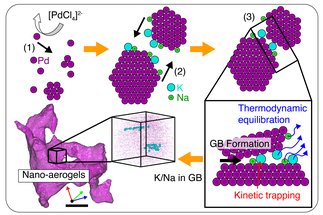Phases, Defects & Microstructure
Defects are crucial in determining materials properties and occur on a wide range of time and length scales, from point defects to extended ones. To simulate the rich world of phase stability, defects, and microstructure, from interstitial doping towards grain boundary mobility, requires advanced and diverse simulation techniques from electronic structure calculations, machine learning, thermodynamic integration and molecular dynamics simulations.
The intense electric fields such as those used in atom probe tomography (APT) can be treated as a degree of freedom for stability of different surface phases of metal. Through density functional theory (DFT) calculations on the Li (110) surface, we identify a critical field strength at which kink sites spontaneously dissolve into mobile adatom states, also enabling barrier-free diffusion across the surface. This suggests the emergence of a fluid-like, 2D adatom gas phase on lithium surfaces under high fields, even at cryogenic temperatures. This phase transition, driven by electrostatic field effects, provides a theoretical framework to explain experimental observations.
[more]
The computational materials design department in collaboration with the Technical University Darmstadt and the Ruhr University Bochum developed a workflow to calculate phase diagrams from ab-initio. This achievement is based on the expertise in the ab-initio thermodynamics in combination with the recent advancements in machine-learned interatomic potentials and the continuous development of the pyiron workflow framework.
[more]
Field ion emission microscopy techniques are a group of characterization tools employing humungous electric fields. Atom probe tomography (APT), field ion microscopy (FIM), field emission microscopy (FEM), analytical field ion microscopy (AFIM) are the few of these. The strong fields applied (10
6-10
10 V/m), induce a host of interesting phenomena at/near the specimen surface. Using density functional theory (DFT) and python based analysis algorithms, we have several projects to aid and inform these characterization routines, to advance and enable new horizons for field ion emission techniques.
[more]
Project C3 of the SFB/TR103 investigates high-temperature dislocation-dislocation and dislocation-precipitate interactions in the gamma/gamma-prime microstructure of Ni-base superalloys.
[more]
Project A02 of the SFB1394 studies dislocations in crystallographic complex phases and investigates the effect of segregation on the structure and properties of defects in the Mg-Al-Ca System.
[more]
Iron oxides and hydroxides of variable stoichiometry occur at the essential stages of iron ore reduction and ferrous metal corrosion (rusting). We aim at building up a fundamental understanding of how the ions (Fe
2+, Fe
3+, O
2-, OH
-) may arrange and rearrange to achieve such a broad composition range, in order to optimize the conditions to improve reduction processes and prevent corrosion.
[more]
A high degree of configurational entropy is a key underlying assumption of many high entropy alloys (HEAs). However, for the vast majority of HEAs very little is known about the degree of short-range chemical order as well as potential decomposition. Recent studies for some prototypical face-centered cubic (fcc) HEAs such as CrCoNi showed that short-range order (SRO) can influence critical materials properties as, e.g., stacking fault energies. For refractory HEAs, due to slow diffusivity chemical ordering may hardly ever be achieved under typical experimental conditions but could potentially influence creep properties long-term applications. In this project we therefore study the phase stability and short-range order of selected fcc as well as bcc refractory HEAs computationally.
[more]
We simulate the ionization contrast in field ion microscopy arising from the electronic structure of the imaged surface. For this DFT calculations of the electrified surface are combined with the Tersoff-Hamann approximation to electron tunneling. The approach allows to explain the chemical contrast observed for NiRe alloys.
[more]
Extremely strong (~10 V/nm) electric fields rupturing atomic bonds is a relatively well-studied concept in the field of molecular chemistry. When extended to crystalline systems, i.e. material surfaces, this concept is known as field evaporation and its exact mechanisms become more challenging to predict. Field evaporation is the central phenomenon that enables atom probe tomography (APT) and 3D field ion microscopy (3D-FIM), and obtaining atomically-accurate APT reconstructions will be impossible without an atomically-accurate understanding of how ions initially form and depart from the surface. By performing first-principles calculations on faceted surfaces under extreme fields, we search for such an understanding in pure metals and alloys.
[more]
Identifying mechanisms for hydrogen contamination of solid materials will help the quantification of H concentration in materials by atom probe tomography (APT) and elucidate open questions regarding H-involving mechanisms, like H embrittlement.
[more]
We study the impurity incorporation mechanisms in metallic nano-aerogels is expected to identify routes to the targeted design of specimens with desired concentrations of impurities.
[more]



